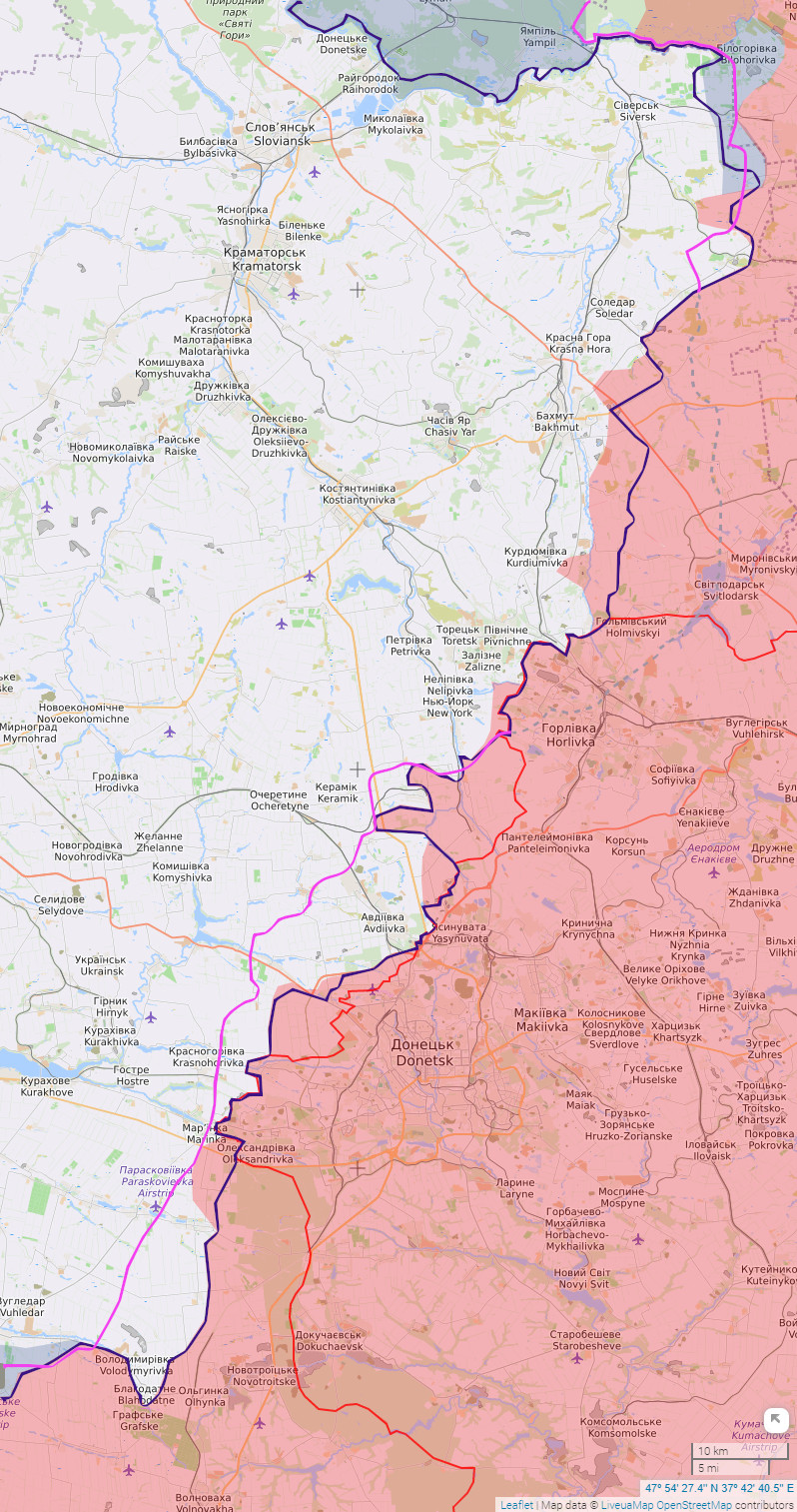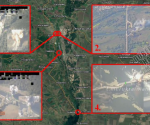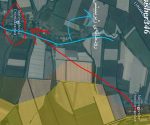Russian gains and Ukrainian losses in Donetsk, 1st September to 7th October
Today we are all of us supposed to be agitated about an explosion that occurred on the road section of the Kerch Strait Bridge that links Crimea with mainland Russia, but at FBEL this cannot and will not be done.
Although the author has seen a certain big-name alternative-media geopolitical analyst twisting a knife in the psychological wounding by linking the incident – a (UK/US/)Ukrainian act of sabotage – with a supposed inevitable as-yet-phantom Ukrainian offensive into Zaporozhe, it was in fact a militarily futile act: the rail section of the bridge has not been seriously damaged, and the author has seen a report citing the railway carriers stating that trains from Simferopol and Sevastopol had already left for Moscow via the bridge. The astute reader will have noticed that the Russians like to transport their military equipment by rail, and will perhaps even have seen video of trainloads of materiel supposedly delivering into the Crimea.
So, instead of being made to retread old ground regarding the meaning of what is in fact a desperate UK/US/Ukrainian act of provocation, the reader is directed to the previous FBEL article, Deliveries Of “Wunderwaffe” To Ukraine Are Not For Turning Tide, Because That Can’t Happen; They’re For Propaganda, And Leading Russians From Their Purpose. Hopefully, especially if the reader follows the trail of links offered in the piece, there’s no more that needs to be said, except how it should be noted that, despite all the bragging over HIMARS, and how it was going to “change the game”, this latest attack was carried out in a very low-tech manner (a bomb in a truck) actually in line with the other ways that Ukraine is being forced to fight the Russians; i.e. the very costly human wave manoeuvres that have lately optimistically been called “offensives”.
* * * * * *
The graphic below shows one liveuamap.com overlaid onto another so that the red shading represents what that organisation (on behalf of the Ukrainians) claim is the extent of Russian control in Donetsk as of 7th October, 2022. The blue line comes from where the same source reckoned for the extent of Russian control on 1st September.
The purple line is one that is reckoned according to a map shown in the Russian Ministry of Defence’s briefing of 7th October, as is the dotted grey line that cuts through the red shading.
The first thing to say about the map is that it shows gains by Russia as reckoned by the Ukrainians – these are represented by the red shading extending beyond the blue line. That the Russians are advancing here is a fact that the Ukrainians can’t deny. More importantly than that, the Russians are doing so against an enemy that is trying to block the advance, thus causing significant casualties – and some figures regarding this consequence of Russian forward motion will be examined at the foot of this piece.
The next thing to speak to is how the Russian version of the front line might look strange in the north – i.e. how it is drawn (dotted grey) so far back in the territory that even the enemy is allowing. It should be stressed that, as odd as appearances go, it is entirely consistent with how the same information was portrayed most recently at this site in the article, Charted: The Demilitarisation Of Ukraine In Donetsk. In other words, the Russians have consistently understated their advance in the north.
It would appear, then, that the Russians are extremely coy about what is happening in the north, to the extent, for instance, of not showing Kodema and Zaytsevo as under their control, even those these settlements have been named explicitly in Ministry of Defence briefings as being so. Kodema is shown on the map on the same line as there is a label for Kurdyumivka, and if the author has the correct “Zaitseve”, it is a settlement to Kodema’s immediate north. Remarkably, both of these are admitted captured by the Russians in the Ukrainian version of the line of control. Given that the Ukrainians would be reluctant to concede ground being lost in this part of the Donetsk theatre (at the risk of spoiling the image of “winning”), and that the Russians are being mysterious in the extreme, it’s quite possible that the latter have gained well beyond any of the parameters stated by either side.
As for the situation of the front in the southern sector, the Russians are not so self-effacing – and never have been, as the map in the abovementioned previous article demonstrates (therefore, this reckoning is consistent with the previous account). Indeed, when the two maps are compared, it is quite noticeable that there has been an increase in territory gained by the Russians all along the line from Novobakhmutivka (where the “rabbit ears” are) to Marinka.
* * * * * *
Wanting to give an impression of the sort of losses that the Ukrainians would have suffered during the Russian offensive into Donetsk in the time period of our interest, the author collated data from Russian Ministry of Defence briefings according to a certain criteria. Not wanting to duplicate work done for the article mentioned above, the data covers 17th September to 7th October, thus representing about 3 weeks’ worth. Information about attacks on ammunition dumps and air defence actions to shoot down drones or projectiles has not been considered.
Because it appears that the Russian MoD briefings primarily report the results of stand-off attacks, it is suggested that the casualty numbers that have been arrived at and shown below do not necessarily include those caused by the mobile elements (rather than the artillery) of Russian ground forces as they engage the enemy face-to-face. This means, incidentally, our impression of Ukrainian casualties very possibly remains incomplete, and most importantly, understated. Be that as it may, with the idea to get a reasonable idea of casualties from these indirect actions in support of the advancing mobile elements, the author has tallied the strikes that have happened in locations no further north than Seversk, and generally no further west than Kramatorsk (so, the casualty numbers arrived at do not represent all Ukrainian losses in Donetsk).
And so, it was found that, subject to the criteria stated above, the Ukrainian losses amounted to
1514 servicemen, 12 tanks, 26 infantry fighting vehicles, 11 armoured vehicles, 131 artillery (or mortar) units, 55 pieces of “military equipment”, 8 pieces of “special military equipment”, 6 motor vehicles, an Mi-8 helicopter, 2 MiG-29 war planes, 3 Su-25 war planes, 2 Su-24 war planes, 2 Buk-M1 self-propelled missile systems, a 155-mm M777 howitzer, 3 S-300 air defence system radars, and 2 batteries of Ukrainian Grad multiple launch rocket system.



















